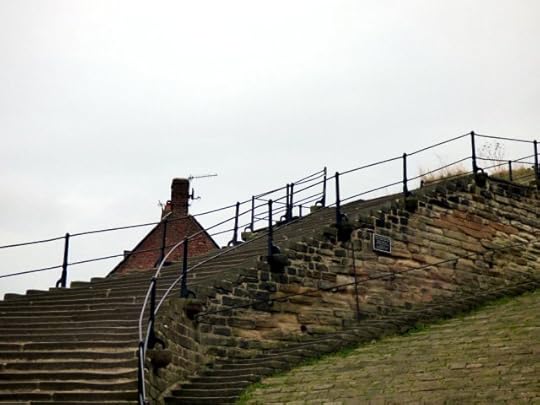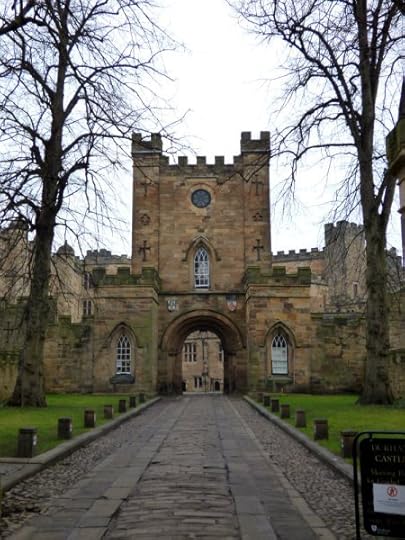Sue Vincent's Blog: Echoes of Life, page 1049
February 11, 2015
Discovering Albion – day 8: The church on the cliff
 The Church of St Mary the Virgin sits high on its cliff above the town. It was founded around 1110AD, during the time of Abbot William de Percy and the exterior reflects the 12th century architecture in golden sandstone. The interior, though dates mainly from the 1700s and is a strange a place as you will see. Historically, it is an important survival. Aesthetically it is a claustrophobic jumble.
The Church of St Mary the Virgin sits high on its cliff above the town. It was founded around 1110AD, during the time of Abbot William de Percy and the exterior reflects the 12th century architecture in golden sandstone. The interior, though dates mainly from the 1700s and is a strange a place as you will see. Historically, it is an important survival. Aesthetically it is a claustrophobic jumble.
 It is difficult to make sense of the space. High sided 18th century box pews, like cattle pens… some marked ‘for strangers only’ fill the main body of the church while upstairs galleries look down. The ‘walls’ of the box pews are so tall that I, for one, could not see into them from the aisles between without making an effort to do so. Some are plain wood, others lined with green baize and others still bear red velvet cushions. A social hierarchy of comfort or piety? Although all is painted in bright, fresh tones, and lit by the huge brass chandeliers that hang from the ceiling, it has, to me, an overbearing atmosphere.
It is difficult to make sense of the space. High sided 18th century box pews, like cattle pens… some marked ‘for strangers only’ fill the main body of the church while upstairs galleries look down. The ‘walls’ of the box pews are so tall that I, for one, could not see into them from the aisles between without making an effort to do so. Some are plain wood, others lined with green baize and others still bear red velvet cushions. A social hierarchy of comfort or piety? Although all is painted in bright, fresh tones, and lit by the huge brass chandeliers that hang from the ceiling, it has, to me, an overbearing atmosphere.
 Right in the centre of what should be the nave is an incongruous, but doubtless practical stove for heating. There is also a three tiered pulpit, all polished wood and red velvet, illustrating the importance of the sermons in the 18th century.. While doubtless this central position is also practical, allowing all the parishioners to both see and hear the minister’s perorations, I could not help feeling that it deprived attention from what should, perhaps, be the focus of the worship in a Christian church… the altar, invisible from most of the church.
Right in the centre of what should be the nave is an incongruous, but doubtless practical stove for heating. There is also a three tiered pulpit, all polished wood and red velvet, illustrating the importance of the sermons in the 18th century.. While doubtless this central position is also practical, allowing all the parishioners to both see and hear the minister’s perorations, I could not help feeling that it deprived attention from what should, perhaps, be the focus of the worship in a Christian church… the altar, invisible from most of the church.
 The place has a strange and cluttered feel. In the few spare corners left by the pews, odd treasures lurk; an iron bound chest, a Saxon coffin for a babe… art and history tucked away in every nook and cranny. The chest is interesting though. It is around 300 years old and has three locks… one each for the vicar and the church wardens. It used to hold the church plate and parish records, but it was stolen in 1743 and thrown over the cliff. The chest was recovered, but the contents were gone.
The place has a strange and cluttered feel. In the few spare corners left by the pews, odd treasures lurk; an iron bound chest, a Saxon coffin for a babe… art and history tucked away in every nook and cranny. The chest is interesting though. It is around 300 years old and has three locks… one each for the vicar and the church wardens. It used to hold the church plate and parish records, but it was stolen in 1743 and thrown over the cliff. The chest was recovered, but the contents were gone.
 It was with a feeling of relief that I approached the quire… a more ancient and traditional space altogether. Here the lovely tones of stone are left on display. The steps are lined with flowers and flanked by a pair of medieval fonts. Three lancet windows are set deep in the east wall of the church and a simple Celtic style cross, carved in wood, hangs above the altar.
It was with a feeling of relief that I approached the quire… a more ancient and traditional space altogether. Here the lovely tones of stone are left on display. The steps are lined with flowers and flanked by a pair of medieval fonts. Three lancet windows are set deep in the east wall of the church and a simple Celtic style cross, carved in wood, hangs above the altar.
 The glass depicts those whose history is entwined with church and Abbey, including St Hilda and Cædmon, along with saints and the dignitaries of the church, for Whitby held a critical place in the history of Christianity in England.
The glass depicts those whose history is entwined with church and Abbey, including St Hilda and Cædmon, along with saints and the dignitaries of the church, for Whitby held a critical place in the history of Christianity in England.
 One thing I really did like, however, was the lack of electric lighting. Until recently electricity was only used in the church to power the organ and a tv monitor. While there is more lighting now, the church when required, is still lit with candles… there are no light bulbs in the chandeliers and sconces. Perhaps when the flames are lit and the shadows dance with warm light, the little church with its square stance and battlemented tower might come into its own and show an inner beauty that transcends its odd appearance. And maybe, after all, that is the real point of such places.
One thing I really did like, however, was the lack of electric lighting. Until recently electricity was only used in the church to power the organ and a tv monitor. While there is more lighting now, the church when required, is still lit with candles… there are no light bulbs in the chandeliers and sconces. Perhaps when the flames are lit and the shadows dance with warm light, the little church with its square stance and battlemented tower might come into its own and show an inner beauty that transcends its odd appearance. And maybe, after all, that is the real point of such places.
 Now [we] must honour the guardian of heaven,
Now [we] must honour the guardian of heaven,
the might of the architect, and his purpose,
the work of the father of glory
as he, the eternal lord, established the beginning of wonders;
he first created for the children of men
heaven as a roof, the holy creator
Then the guardian of mankind,
the eternal lord, afterwards appointed the middle earth,
the lands for men, the Lord almighty.
Cædmon’s Hymn, composed between 658 and 680AD.

Discovering Albion – day 8: 199 steps
 I’ve always had a soft spot for Whitby. Even the trip to get there from my childhood home takes you across the North York Moors and if you are lucky enough to go in summer, chances are the heather will be in full bloom from horizon to horizon. This time, however, we just had the bitter winter wind. Not that this was a bad thing at that moment… it made the climb up the 199 worn sandstone steps less of a warming experience. In summer it is hot work. Like all such things there is the tradition that you cannot count them. I, at least, have never managed it… I get distracted.
I’ve always had a soft spot for Whitby. Even the trip to get there from my childhood home takes you across the North York Moors and if you are lucky enough to go in summer, chances are the heather will be in full bloom from horizon to horizon. This time, however, we just had the bitter winter wind. Not that this was a bad thing at that moment… it made the climb up the 199 worn sandstone steps less of a warming experience. In summer it is hot work. Like all such things there is the tradition that you cannot count them. I, at least, have never managed it… I get distracted.
 From here there are wonderful views over the little town and its harbour. Whitby still depends on the sea for most of its income, though the whaling and herring fishing has long since declined to be largely replaced with tourism and the manufacture of jet jewellery… and fossils of course. There are so many to pick up on the beaches here, released by the constant erosion of the cliffs.
From here there are wonderful views over the little town and its harbour. Whitby still depends on the sea for most of its income, though the whaling and herring fishing has long since declined to be largely replaced with tourism and the manufacture of jet jewellery… and fossils of course. There are so many to pick up on the beaches here, released by the constant erosion of the cliffs.
 Of course, as we climbed up to the church and saw the disappearing cliff face over the town, I recalled that it is not only fossils that the wind and rain releases. That cliff face has eroded by a good distance since I was a child and human bones from the graveyard have been sent into the streets below by the landslips that have placed homes beneath the cliff at significant risk. If that sounds like something from a horror movie there is reason for that too… Bram Stoker set much of his book Dracula against the stark silhouette of the Abbey and church atop the cliff.
Of course, as we climbed up to the church and saw the disappearing cliff face over the town, I recalled that it is not only fossils that the wind and rain releases. That cliff face has eroded by a good distance since I was a child and human bones from the graveyard have been sent into the streets below by the landslips that have placed homes beneath the cliff at significant risk. If that sounds like something from a horror movie there is reason for that too… Bram Stoker set much of his book Dracula against the stark silhouette of the Abbey and church atop the cliff.
 There are a lot of literary associations with Whitby through the ages, of course. The Whitby Gazette carried the first published works of Lewis Carroll, author of Alice’s Adventures in Wonderland and Through the Looking-Glass, back in 1854. But perhaps more importantly it was the home of Cædmon, the earliest English poet whose name is still known to us.
There are a lot of literary associations with Whitby through the ages, of course. The Whitby Gazette carried the first published works of Lewis Carroll, author of Alice’s Adventures in Wonderland and Through the Looking-Glass, back in 1854. But perhaps more importantly it was the home of Cædmon, the earliest English poet whose name is still known to us.
 Cædmon tended the beasts at the Abbey during the time of St Hilda when was the Abbess here. (657–680) The venerable Bede, writing a few years later tells us that ‘the art of song’ came to Cædmon in a dream and that, writing in Old English, he was able to take the stories of the scriptures and transpose them into works by which “…the minds of many were often excited to despise the world, and to aspire to heaven.” Only a fragment of his work survives today… just nine lines.
Cædmon tended the beasts at the Abbey during the time of St Hilda when was the Abbess here. (657–680) The venerable Bede, writing a few years later tells us that ‘the art of song’ came to Cædmon in a dream and that, writing in Old English, he was able to take the stories of the scriptures and transpose them into works by which “…the minds of many were often excited to despise the world, and to aspire to heaven.” Only a fragment of his work survives today… just nine lines.
 As we reached the top of the 199 Church Steps we saw the carved stone cross erected in his honour upon which the lines have now been carved… a modern version, erected in 1898, very reminiscent of the cross at Ruthwell that we had seen days before, even down to the inscriptions running along the edges. Some of the patterns were taken from the Lindisfarne Gospel… and to see the cross here linking back through the centuries and our journey, at a place so pivotal to the history of Christianity in Britain, was a strange feeling. These threads all tie together, part of a richer tapestry whose design we are perhaps too close to see.
As we reached the top of the 199 Church Steps we saw the carved stone cross erected in his honour upon which the lines have now been carved… a modern version, erected in 1898, very reminiscent of the cross at Ruthwell that we had seen days before, even down to the inscriptions running along the edges. Some of the patterns were taken from the Lindisfarne Gospel… and to see the cross here linking back through the centuries and our journey, at a place so pivotal to the history of Christianity in Britain, was a strange feeling. These threads all tie together, part of a richer tapestry whose design we are perhaps too close to see.
 It was going up for three o’clock as we headed towards the church, seeing the gentle scars of the changing building in its mellow stone. Once again we were lucky and found the doors open to visitors in spite of the time of year. We wondered what else we might find…
It was going up for three o’clock as we headed towards the church, seeing the gentle scars of the changing building in its mellow stone. Once again we were lucky and found the doors open to visitors in spite of the time of year. We wondered what else we might find…

Discovering Albion – day 8: Whitby
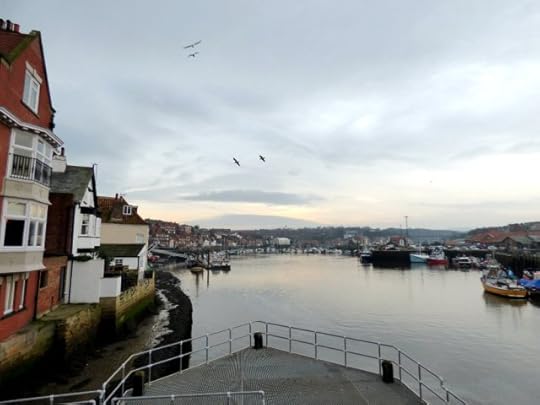 A bitterly cold day in mid-January is not, I have to say, the ideal time to go to the seaside. Especially not in North Yorkshire. But go we did. I have fond memories of Whitby as a child…sitting on the beach in summer, huddled in a sweater and drinking Horlicks brought on a tray from the café at the top of the slip. I brought my own children here when they were very young too, though to be fair, it had been at least slightly warmer. Probably not quite as icily cold.
A bitterly cold day in mid-January is not, I have to say, the ideal time to go to the seaside. Especially not in North Yorkshire. But go we did. I have fond memories of Whitby as a child…sitting on the beach in summer, huddled in a sweater and drinking Horlicks brought on a tray from the café at the top of the slip. I brought my own children here when they were very young too, though to be fair, it had been at least slightly warmer. Probably not quite as icily cold.
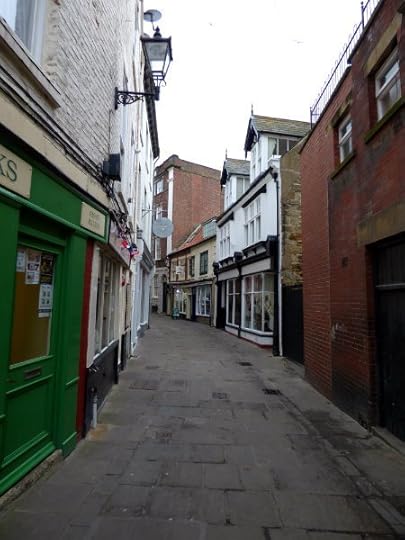 Not that I cared. I love Whitby and it has roots in my family: I pointed out the house one of my ancestors used to live in a few centuries ago. I had been delighted when I traced the family back to a specific house still standing from 17th century Whitby and one of these days may see how far back that association went. My companion too has links with Whitby, though they are of a more mysterious nature and my lips are sealed… First things first though. We needed a pub. With lunch… and a fire.
Not that I cared. I love Whitby and it has roots in my family: I pointed out the house one of my ancestors used to live in a few centuries ago. I had been delighted when I traced the family back to a specific house still standing from 17th century Whitby and one of these days may see how far back that association went. My companion too has links with Whitby, though they are of a more mysterious nature and my lips are sealed… First things first though. We needed a pub. With lunch… and a fire.
 We found both in the Dolphin, right beside the swing bridge that allows the fishing boats out of the Esk and into the sea. Yes, another Esk… first Cumbria, then Scotland… now Yorkshire. There was something a bit coincidental about that. Of all the rivers in all the country… we get three Esks in special places.
We found both in the Dolphin, right beside the swing bridge that allows the fishing boats out of the Esk and into the sea. Yes, another Esk… first Cumbria, then Scotland… now Yorkshire. There was something a bit coincidental about that. Of all the rivers in all the country… we get three Esks in special places.
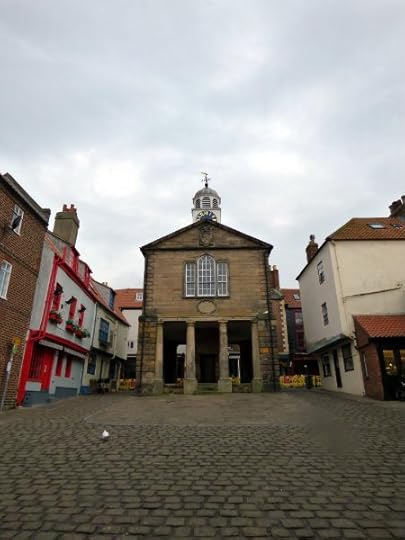 After lunch we wandered into the old town to the south of the river estuary. Even here there were few tourists. Not surprising given that the temperature had dropped even further, though we were at least sheltered from the wind. I, of course, needed a Lucky Duck. It’s traditional. They were first made half a century ago as lucky charms for actors at the theatre in the town. I was given one every time we went to Whitby. I bought them for my sons. Now I needed one for my granddaughter.
After lunch we wandered into the old town to the south of the river estuary. Even here there were few tourists. Not surprising given that the temperature had dropped even further, though we were at least sheltered from the wind. I, of course, needed a Lucky Duck. It’s traditional. They were first made half a century ago as lucky charms for actors at the theatre in the town. I was given one every time we went to Whitby. I bought them for my sons. Now I needed one for my granddaughter.
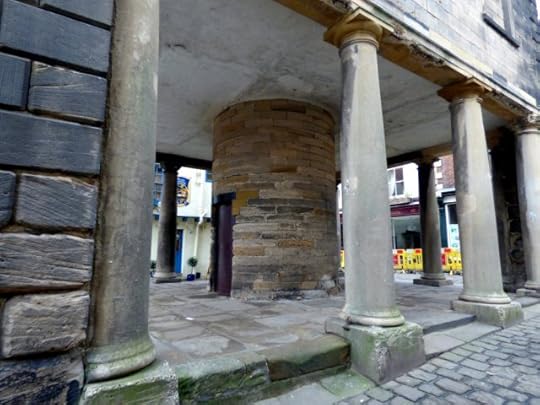 With the little Murano glass duck in my handbag we set off to explore. The glass shop sits just off Church Street, with its tiny, columned market built by Nathanial Cholmley in 1788. The old, narrow streets seem to huddle together here and all styles and periods can be traced within them. Small alleys with names like Arguments Yard run off Church Street and I know from past explorations that cobbled courtyards and unknown treasures lie hidden in many of them.
With the little Murano glass duck in my handbag we set off to explore. The glass shop sits just off Church Street, with its tiny, columned market built by Nathanial Cholmley in 1788. The old, narrow streets seem to huddle together here and all styles and periods can be traced within them. Small alleys with names like Arguments Yard run off Church Street and I know from past explorations that cobbled courtyards and unknown treasures lie hidden in many of them.
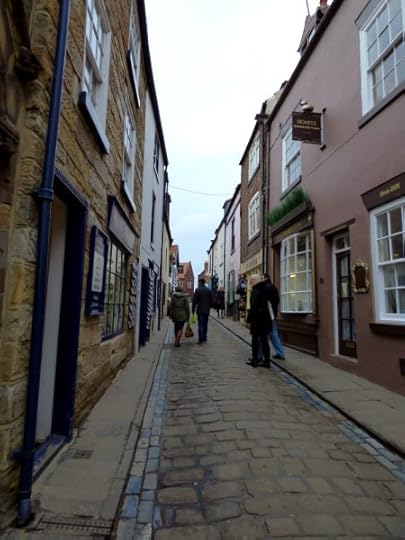 I tried not to drool over the jet in the windows. I’ve always had a thing about proper jet… not ‘french jet’ which is actually glass and cold, but the warm black depth of Whitby Jet… a fossilized wood some 182 million years old and prized since Neolithic times for jewellery. It came to the height of its popularity in the time of Queen Victoria as mourning jewellery and some fantastic pieces of craftsmanship survive. Today, of course, it is the gem of choice for the Goths who frequent Whitby and those who come here for the vampire connection. Bram Stoker set part of his Dracula in the town, inspired by the ruined Abbey and the church perched high on the cliff top. Which, even though we had said we would not, was where we were going next. Up to the cliff top via the famous 199 steps.
I tried not to drool over the jet in the windows. I’ve always had a thing about proper jet… not ‘french jet’ which is actually glass and cold, but the warm black depth of Whitby Jet… a fossilized wood some 182 million years old and prized since Neolithic times for jewellery. It came to the height of its popularity in the time of Queen Victoria as mourning jewellery and some fantastic pieces of craftsmanship survive. Today, of course, it is the gem of choice for the Goths who frequent Whitby and those who come here for the vampire connection. Bram Stoker set part of his Dracula in the town, inspired by the ruined Abbey and the church perched high on the cliff top. Which, even though we had said we would not, was where we were going next. Up to the cliff top via the famous 199 steps.
Discovering Albion – day 8: Lythe
 … And suddenly we were in Yorkshire again, where our trip together had begun. It was almost over. But then, Yorkshire is a big county… we had things still to see and another night before we headed back to Sheffield. The weather had curiously turned bleaker and colder the further south we went and there was more snow in Yorkshire than we had seen in Scotland save on the distant mountains.
… And suddenly we were in Yorkshire again, where our trip together had begun. It was almost over. But then, Yorkshire is a big county… we had things still to see and another night before we headed back to Sheffield. The weather had curiously turned bleaker and colder the further south we went and there was more snow in Yorkshire than we had seen in Scotland save on the distant mountains.
 We turned once more to the coastal road that had served us so well through Cumbria and Scotland and headed southwards to the tiny village of Lythe, just north of Whitby. Friends had told us there were Saxon remains there in the church, though we had little idea what to expect. We had seen a couple of pictures, but were, perhaps, less than enthusiastic as we squelched through the mud of the farm track where we had parked and walked through the biting wind to the tiny church of St Oswald. In fact, what we expected was to find it locked.
We turned once more to the coastal road that had served us so well through Cumbria and Scotland and headed southwards to the tiny village of Lythe, just north of Whitby. Friends had told us there were Saxon remains there in the church, though we had little idea what to expect. We had seen a couple of pictures, but were, perhaps, less than enthusiastic as we squelched through the mud of the farm track where we had parked and walked through the biting wind to the tiny church of St Oswald. In fact, what we expected was to find it locked.
 We were, however, in luck, and by a curious coincidence, the couple just leaving had signed the visitors’ book and were from the same district in Sheffield as my companion. I would urge anyone visiting the old churches to sign the books… funding for the preservation of many of these historic sites can be influenced by the number of visitors.
We were, however, in luck, and by a curious coincidence, the couple just leaving had signed the visitors’ book and were from the same district in Sheffield as my companion. I would urge anyone visiting the old churches to sign the books… funding for the preservation of many of these historic sites can be influenced by the number of visitors.
 A simple little place, St Oswald’s. Very much what we have come to expect. A wooden church from around 900AD, replaced by stone in Norman times, probably around 1200AD. A central nave, aisles north and south and a raised chancel beyond the arch. Very pretty, very peaceful… and lovely stained glass in the windows. A very fine modern screen, dating from 1910, separates nave from choir, and the ceiling is painted. Sadly, many of the original Norman features were lost during 19th century restoration, as is the case with so many of our old churches.
A simple little place, St Oswald’s. Very much what we have come to expect. A wooden church from around 900AD, replaced by stone in Norman times, probably around 1200AD. A central nave, aisles north and south and a raised chancel beyond the arch. Very pretty, very peaceful… and lovely stained glass in the windows. A very fine modern screen, dating from 1910, separates nave from choir, and the ceiling is painted. Sadly, many of the original Norman features were lost during 19th century restoration, as is the case with so many of our old churches.
 The best bit for us, of course, was the west end of the church… neatly turned out as a mini museum to house a collection of ancient stones, complete with a comprehensive set of information. We had fragments of carved crosses and hogback stones; Viking and Saxon stonework… a medieval Green Man… and some wonderful imagery to work with. And, had we been able to predict when we would actually make it to Lythe, there is a crypt full of other stones that can be seen by appointment…!
The best bit for us, of course, was the west end of the church… neatly turned out as a mini museum to house a collection of ancient stones, complete with a comprehensive set of information. We had fragments of carved crosses and hogback stones; Viking and Saxon stonework… a medieval Green Man… and some wonderful imagery to work with. And, had we been able to predict when we would actually make it to Lythe, there is a crypt full of other stones that can be seen by appointment…!
 The hogback bears an incised image of the Lythe ‘gingerbread man’. He does look remarkably like the modern confection, but has a far more interesting story to tell. The hogback was placed in the churchyard almost a hundred years ago during a renovation and left to gather moss. When it was cleaned in 2007 the figure was uncovered. I have to say, I entirely approve of many of the information boards in this little museum… particularly as they accord with some of the conclusions to which we had already been brought as we work on our books together.
The hogback bears an incised image of the Lythe ‘gingerbread man’. He does look remarkably like the modern confection, but has a far more interesting story to tell. The hogback was placed in the churchyard almost a hundred years ago during a renovation and left to gather moss. When it was cleaned in 2007 the figure was uncovered. I have to say, I entirely approve of many of the information boards in this little museum… particularly as they accord with some of the conclusions to which we had already been brought as we work on our books together.
 Then there were the wrestlers. The footwork looks fairly self-explanatory on the humans, though the characters involved are up for debate. On the other hand the horse like beast below the two figures seems to have scales and appears at least to have an unconscionable amount of legs yet again. Say, for instance, about eight yet… again… which of course brings us back to Brechin, Bakewell and the other stones depicting Odin’s steed, Sleipnir. Though admittedly, it is difficult to be sure what were carved as legs and what is damage after over a thousand years.
Then there were the wrestlers. The footwork looks fairly self-explanatory on the humans, though the characters involved are up for debate. On the other hand the horse like beast below the two figures seems to have scales and appears at least to have an unconscionable amount of legs yet again. Say, for instance, about eight yet… again… which of course brings us back to Brechin, Bakewell and the other stones depicting Odin’s steed, Sleipnir. Though admittedly, it is difficult to be sure what were carved as legs and what is damage after over a thousand years.
 Of course, we have to mention the tympanum, though I’m not entirely sure what to say… A fragment of a 12th century panel that would have filled the arch of the Norman door. The inscription says it is probably a passage from Genesis referring to Adam, Eve and the Tree of Life. If so, I have to say, the imagery seems a tad unorthodox and the symbolism leaves much open to question.
Of course, we have to mention the tympanum, though I’m not entirely sure what to say… A fragment of a 12th century panel that would have filled the arch of the Norman door. The inscription says it is probably a passage from Genesis referring to Adam, Eve and the Tree of Life. If so, I have to say, the imagery seems a tad unorthodox and the symbolism leaves much open to question.
 The Cross head is unusual in Yorkshire, having more in common with the Irish High Crosses than local work. It dates from the mid 800s to 900s AD. The back of the cross is simple interlaced carved with a central boss. The central head on the front face bears no halo and ‘may not be a representation of Christ’. Either way, it is a beautiful thing and the purple of the heather before it seemed perfect to me. It would of course. The heather covered hills of Yorkshire are my home… even covered in snow.
The Cross head is unusual in Yorkshire, having more in common with the Irish High Crosses than local work. It dates from the mid 800s to 900s AD. The back of the cross is simple interlaced carved with a central boss. The central head on the front face bears no halo and ‘may not be a representation of Christ’. Either way, it is a beautiful thing and the purple of the heather before it seemed perfect to me. It would of course. The heather covered hills of Yorkshire are my home… even covered in snow.

February 10, 2015
Dear Wen XV
 Originally posted on Stuart France:
Originally posted on Stuart France:
 All in good time my dearest Wendolina…
All in good time my dearest Wendolina…
I have more than enough to be going on with at present with the Ilkley ‘crosses’… It sounds like our little trip has fired you up somewhat… the lion slaying David would certainly have things in common with both Samson and Herakles for starters…I should imagine.
 And as for your query relating to Pagan Streams? (Nice phrase) All of them I shouldn’t wonder, ‘iconotropy’… i.e. turning icons to different mythological purposes was something of an occupational hazard for the ‘churchmen’…
And as for your query relating to Pagan Streams? (Nice phrase) All of them I shouldn’t wonder, ‘iconotropy’… i.e. turning icons to different mythological purposes was something of an occupational hazard for the ‘churchmen’…
The point is though that neither need be correct.
The myths in many cases are derived from the pictures, not the other way around which is how we tend to imagine it works partly because we are so used to reading books which have illustrations.
We shouldn’t be too surprised. We have worked with the Tarot… one only has to consider what bringing…
View original 258 more words

Discovering Albion – day 8: Durham Cathedral

The Rose Window © Durham Cathedral and Jarold Printing
The cathedral of Durham is one of the finest Norman buildings and a World Heritage site. It stands on a rocky height above a loop in the River Wear, a perfect place defensively. At the time of its establishment it fell under the protection of the Earl of Northumberland, a kinsman of the Bishop.
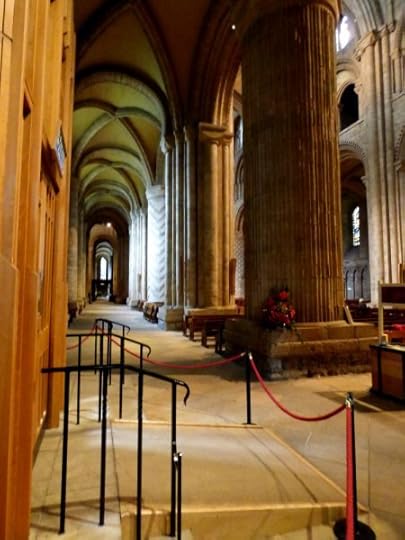 History tells how the relics of St Cuthbert of Lindisfarne were borne with love by his Brethren to Chester-le-Street when the raids of the Danes forced them to flee Holy Island in 875AD, taking the relics with them. A shrine was set up there to the saint, but they were obliged to leave there too in 995. Legend tells they wandered until, following two milkmaids searching for a dun cow, the coffin became immovable. This was taken as a sign that here the new church should be built. On the external walls a carving can be seen of the milkmaids and the cow… and a nearby street bears the name of the Dun Cow.
History tells how the relics of St Cuthbert of Lindisfarne were borne with love by his Brethren to Chester-le-Street when the raids of the Danes forced them to flee Holy Island in 875AD, taking the relics with them. A shrine was set up there to the saint, but they were obliged to leave there too in 995. Legend tells they wandered until, following two milkmaids searching for a dun cow, the coffin became immovable. This was taken as a sign that here the new church should be built. On the external walls a carving can be seen of the milkmaids and the cow… and a nearby street bears the name of the Dun Cow.
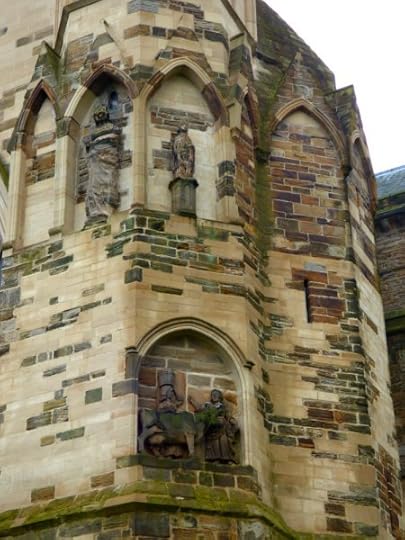 Initially a small wooden structure was raised, then enlarged to house the relics of the saint. In 1080 William of St. Carilef was installed as the first prince-bishop by William the Conqueror and it was he who caused the building of the present Cathedral, which continued after his death. The massive pillars, carved with the distinctive Norman chevron resemble those of Dunfermline Cathedral and as there were ties between the two it is thought the same masons may have worked on both buildings.
Initially a small wooden structure was raised, then enlarged to house the relics of the saint. In 1080 William of St. Carilef was installed as the first prince-bishop by William the Conqueror and it was he who caused the building of the present Cathedral, which continued after his death. The massive pillars, carved with the distinctive Norman chevron resemble those of Dunfermline Cathedral and as there were ties between the two it is thought the same masons may have worked on both buildings.

Shrine of St Cuthbert © Durham Cathedral and Jarold Printing
St Cuthbert’s relics were installed in a new shrine behind the altar of the cathedral. When the tomb was opened in 1104 the tiny Gospel that belonged to the saint was removed along with the silk vestments laid there by King Æthelstan in the 10th century. The Gospel is preserved in the British Library, the vestments remain one of the finest examples of Anglo-Saxon embroidery.

Image: anglicansonline.org
The shrine itself was destroyed at the time of Henry VIII’s Dissolution of the Monasteries, but the relics were spared. Cuthbert’s coffin was later preserved when the tomb was again opened in 1827, reconstructed to show the rare carved Saxon wood and a gold and garnet cross recovered that has become an emblem of the saint.
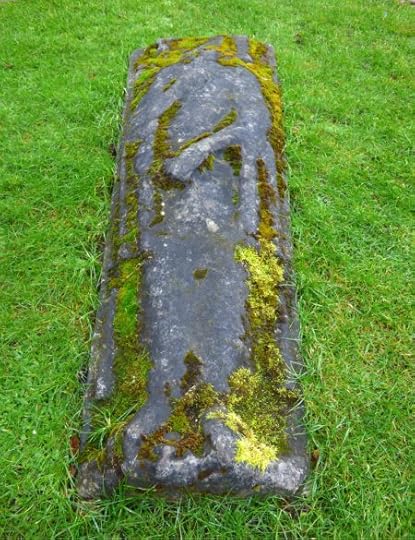 There is a legend that tells that the real remains of Cuthbert were removed from the tomb before Henry VIII’s officials arrived at the cathedral; his body replaced with that of a more recently deceased monk. The tale says that to this day only twelve brothers know the true location of the saint’s relics and as one dies, the secret is passed on. Fact or fiction? We will probably never know.
There is a legend that tells that the real remains of Cuthbert were removed from the tomb before Henry VIII’s officials arrived at the cathedral; his body replaced with that of a more recently deceased monk. The tale says that to this day only twelve brothers know the true location of the saint’s relics and as one dies, the secret is passed on. Fact or fiction? We will probably never know.

Tomb of the Venerable Bede © Durham Cathedral and Jarrold Publishing
Cuthbert is not the only saint whose remains are housed at Durham. The Venerable Bede, writer of the Historia ecclesiastica gentis Anglorum, called the first historian of Britain lies beneath a marble slab, along with many figured known to history. It is a beautiful place… The rose window above the Chapel of Nine Altars is worth the trip all on its own.
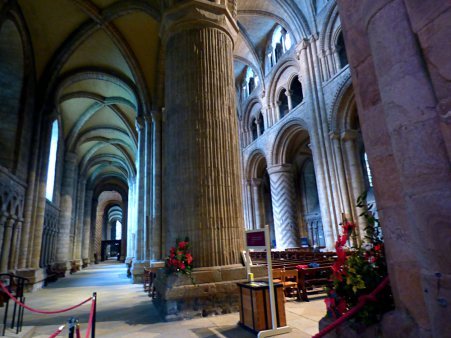 Yet perhaps the single detail that brought home the human side of the church was the bronze door knocker on the huge North Door. This is the symbol of the tradition of Sanctuary offered by the cathedral to all those who were in trouble with the law… a law much harsher once upon a time than it is now. The present knocker is a perfect replica of the 12th century lion fugitives would use to attract the attention of the clergy. Once within the church they would don a black robe with a yellow cross of St Cuthbert on the shoulder. They would confess their crime to the clergy who would then care for them, house and feed them for 37 days, after which they had to leave, either to their death by execution, or to be escorted by the constables to a seaport where they would to leave the country. In a harsh world, this may have been the only hope for those accused of serious crime.
Yet perhaps the single detail that brought home the human side of the church was the bronze door knocker on the huge North Door. This is the symbol of the tradition of Sanctuary offered by the cathedral to all those who were in trouble with the law… a law much harsher once upon a time than it is now. The present knocker is a perfect replica of the 12th century lion fugitives would use to attract the attention of the clergy. Once within the church they would don a black robe with a yellow cross of St Cuthbert on the shoulder. They would confess their crime to the clergy who would then care for them, house and feed them for 37 days, after which they had to leave, either to their death by execution, or to be escorted by the constables to a seaport where they would to leave the country. In a harsh world, this may have been the only hope for those accused of serious crime.
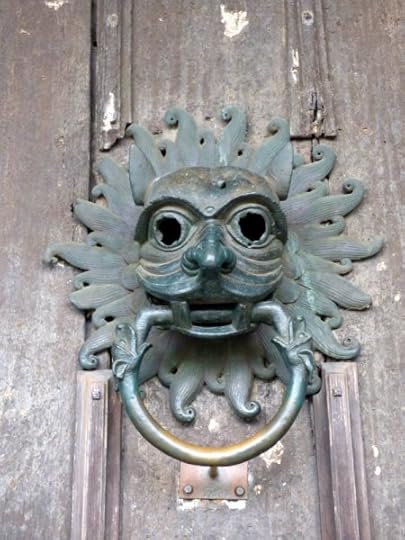 Opposite the cathedral stands a Norman castle and keep, part of the Palatinate of the Prince-Bishops of Durham and still in use today. I was glad to have seen the place, but it was a fleeting visit. We had smaller fish to fry on the North Yorkshire coast. Smaller… but far more satisfying…
Opposite the cathedral stands a Norman castle and keep, part of the Palatinate of the Prince-Bishops of Durham and still in use today. I was glad to have seen the place, but it was a fleeting visit. We had smaller fish to fry on the North Yorkshire coast. Smaller… but far more satisfying…

Discovering Albion – day 8: Soapbox…
 It was getting late by the time we left the island. Ten miles back to the last hotel we had passed or forge ahead and see what happened? We forged ahead and fell lucky, finding a little place north of Alnwick where we could spend the night. Next morning we were up and away early, breaking our fast on the provisions with which we had stocked the car… and deciding, in true Hobbit fashion, that second breakfast could be had in Durham.
It was getting late by the time we left the island. Ten miles back to the last hotel we had passed or forge ahead and see what happened? We forged ahead and fell lucky, finding a little place north of Alnwick where we could spend the night. Next morning we were up and away early, breaking our fast on the provisions with which we had stocked the car… and deciding, in true Hobbit fashion, that second breakfast could be had in Durham.

Jumping Bean
We found a superb little place in the city centre… the Jumping Bean Café. I warn you, stay clear… unless, of course, you want to end up addicted to crumpets covered in toasted cheese. In which case, I highly recommend it. We looked at the artwork on the walls and watched a pied wagtail on the decking as we waited, curious to taste this unheard-of combination. Cheesey crumpets were, we decided after the first bite, definitely the way forward…

Friendly chaffinch…
The police had reopened the bridge across the river by the time we had done; the body floating in the water had been recovered and turned out to be no more than a log washed downstream. We wandered through the ancient alleyways… ginnels we would call them in Yorkshire… and up towards the castle and Cathedral. A huge memorial cross in the Celtic style dominates the green, but is dwarfed beside the majesty of the cathedral itself.

narrow ways
Now, you’ll have to excuse me but there are a couple of things that get my goat and I fail to understand either of them. No flash photography within the Cathedral… no photographs in the chapels set aside for prayer… those I can understand. The first may cause damage to delicate materials… and I never use a flash in historic places for that reason. The second is unfair and distracting to those who are simply there to pray.

Medieval arms.. though I still say it looks like the Loch Ness monster on that helmet…
But no photography at all… sometimes ‘for copyright reasons’… on a building whose copyright probably ran out the best part of a millennium ago… this I fail to understand. Obviously they want you to buy their illustrated guides. But then there is copyright on the images…

Memorial cross and cathedral
Unfortunately the first thing I ever do when walking into any church is turn towards the altar end with the camera and take at least one picture. For the colours we talked about in The Initiate… So I had taken two pictures before we got in as far as the sign that said we couldn’t.

Norman castle keep
The other thing, that really gets to me…of which Durham at least, I have to say, is not guilty is charging entry. To a church. Either a house of prayer, or important parts of the national history and heritage, depending upon your religious bias. And some of them charge £18 per person. Which makes it bloody expensive to visit, say, Westminster Abbey… Now, I know these buildings take a lot of upkeep and the cost of renovation and preservation is huge. But make it discretionary, please. Or charge an affordable price at least. Charge, by all means, to visit the bits normally out of bounds… like the tower or the crypt … that’s fair enough. It makes it a choice. It doesn’t prohibit people from visiting these wonderful buildings on purely economic grounds. Even Jesus got angry at usury in the Temple…

City streets
As a matter of course we always leave a small donation in the boxes of the little places we visit…or buy the little guides…We value our history deeply and want to see it preserved for future generations to enjoy as much as we do. But charging entry at such elevated prices…? It only serves to exclude the poor.

Cathedral
I know that entry is usually free to the services held in the chapels of these great buildings, but for those who wish to touch the heart of the nation’s history and perhaps show their children the wonders they themselves saw when they were young… it should not become a financial impossibility surely?
Okay, I’ll shush and we’ll continue the tour…

Discovering Albion – day 7: Sunset
 We walked up to the Heugh, a high point of the island, to watch the sun set in the west. Once there was a fort here and some of the ruined walls remain, providing a little shelter from the prevailing wind. There are the remains too of the Lantern Chapel that may have been a beacon and lookout point.
We walked up to the Heugh, a high point of the island, to watch the sun set in the west. Once there was a fort here and some of the ruined walls remain, providing a little shelter from the prevailing wind. There are the remains too of the Lantern Chapel that may have been a beacon and lookout point.
 The view from here today is spectacular, looking inland onto the ruins of the twelfth century Priory, eastwards to the castle and along the coast of the mainland to where the silhouette of Bamburgh castle punctuates the horizon and the day markers of Guile Point reach for the sky.
The view from here today is spectacular, looking inland onto the ruins of the twelfth century Priory, eastwards to the castle and along the coast of the mainland to where the silhouette of Bamburgh castle punctuates the horizon and the day markers of Guile Point reach for the sky.
 The light was amazing, turning the pink sandstone to red then gold, painting the landscape with long shadows and glittering on the water, casting an aurulent pathway to the sun. Below we could see the little spit of land, no more than a sea rock cut off from the island by the tide, where St Cuthbert’s chapel once stood.
The light was amazing, turning the pink sandstone to red then gold, painting the landscape with long shadows and glittering on the water, casting an aurulent pathway to the sun. Below we could see the little spit of land, no more than a sea rock cut off from the island by the tide, where St Cuthbert’s chapel once stood.
 A simple cross stands on the tiny islet. It was to here the saint retreated in search of solitude, and later further still to the island of Farne. Legends say that like St Francis his rapport with the birds and beasts was great. He would talk to the birdsthat flocked around him and the seals would come and sit at his feet, warming them against the frozen north wind that blew across the sea.
A simple cross stands on the tiny islet. It was to here the saint retreated in search of solitude, and later further still to the island of Farne. Legends say that like St Francis his rapport with the birds and beasts was great. He would talk to the birdsthat flocked around him and the seals would come and sit at his feet, warming them against the frozen north wind that blew across the sea.
 Certainly the birds were still with us as we climbed past the simple memorial cross, designed by Lutyens in memory of those who lost their lives to war. The shocking number of crosses at its foot may be more a reflection of those who remain than the number of dead, but the tiny population of the island means that few families escaped unscathed by conflict.
Certainly the birds were still with us as we climbed past the simple memorial cross, designed by Lutyens in memory of those who lost their lives to war. The shocking number of crosses at its foot may be more a reflection of those who remain than the number of dead, but the tiny population of the island means that few families escaped unscathed by conflict.
 From here we could look down into the precinct of the Priory, seeing the lovely rainbow arch, the remains of the old crossing tower and the plan of the precinct. This corner of the island, with the village nestled against it, is the home of so much history.
From here we could look down into the precinct of the Priory, seeing the lovely rainbow arch, the remains of the old crossing tower and the plan of the precinct. This corner of the island, with the village nestled against it, is the home of so much history.
 The ruined priory had been the home of monks and the artistry that created the Lindisfarne Gospels. It had seen the lives of saints unfold through the 7th century and known the rabid bloodshed of the Danes when they decimated the little community. And yet, for 1400 years the light of their faith had been kept burning.
The ruined priory had been the home of monks and the artistry that created the Lindisfarne Gospels. It had seen the lives of saints unfold through the 7th century and known the rabid bloodshed of the Danes when they decimated the little community. And yet, for 1400 years the light of their faith had been kept burning.
 We watched, gradually becoming colder and colder, as the sun sank behind the distant hills. The chill barely mattered in face of such beauty. Plumes of birds flew overhead in the silence, solitary wings crossed the aureate glow and cries of haunting magic drew us into their spell.
We watched, gradually becoming colder and colder, as the sun sank behind the distant hills. The chill barely mattered in face of such beauty. Plumes of birds flew overhead in the silence, solitary wings crossed the aureate glow and cries of haunting magic drew us into their spell.
 We watched until the last sliver of gold poured itself along the hilltops, then, as the light changed once more, made our way back to the village and the warmth of the fire in the Crown and Anchor. There we partook of suitable refreshment before a wander back to the car beneath the crescent moon to collect the laptop.
We watched until the last sliver of gold poured itself along the hilltops, then, as the light changed once more, made our way back to the village and the warmth of the fire in the Crown and Anchor. There we partook of suitable refreshment before a wander back to the car beneath the crescent moon to collect the laptop.
 We whiled away the time until the tide would turn working on a project near completion in the homely warmth of the pub, surrounded by the unmistakable smell of coal fires and childhood. It was pitch black by the time we were ready to leave and make the crossing back to the mainland as the tide receded from the causeway.
We whiled away the time until the tide would turn working on a project near completion in the homely warmth of the pub, surrounded by the unmistakable smell of coal fires and childhood. It was pitch black by the time we were ready to leave and make the crossing back to the mainland as the tide receded from the causeway. The drive was surreal. There are, of course, no lights to guide you, no kerbs to prevent straying, no luminous paint or glowing cats eyes… just a flat causeway snaking through the sand in the dark, gleaming with seaweed and receding water. It didn’t help that one of my headlight bulbs chose that moment to fail. The layer of deposited sand made it impossible to see the edges of the roadway and it is not a drive I will forget in a hurry. There seems nothing but you and the sea…the world stops.But then, it had been slowing all afternoon and had disappeared with the sun. It had been a time out of the world somehow… a threshold crossed into a magical land; an island beyond the mists of time.
The drive was surreal. There are, of course, no lights to guide you, no kerbs to prevent straying, no luminous paint or glowing cats eyes… just a flat causeway snaking through the sand in the dark, gleaming with seaweed and receding water. It didn’t help that one of my headlight bulbs chose that moment to fail. The layer of deposited sand made it impossible to see the edges of the roadway and it is not a drive I will forget in a hurry. There seems nothing but you and the sea…the world stops.But then, it had been slowing all afternoon and had disappeared with the sun. It had been a time out of the world somehow… a threshold crossed into a magical land; an island beyond the mists of time.

February 9, 2015
Discovering Albion – day 7: Rose-gold stone
 The Parish Church of Saint Mary the Virgin on Holy Island is thought to stand on the spot where St Aidan founded the first small church around 634AD. Bede wrote of the old church that it was a thatched affair, built with old oak and unsuitable for Abbot or Bishop. A later stone church was built, and eventually the Priory that now stands in skeletal splendour against the sky.
The Parish Church of Saint Mary the Virgin on Holy Island is thought to stand on the spot where St Aidan founded the first small church around 634AD. Bede wrote of the old church that it was a thatched affair, built with old oak and unsuitable for Abbot or Bishop. A later stone church was built, and eventually the Priory that now stands in skeletal splendour against the sky.
 There has been a place of Christian worship on this spot for some 1400 years. Within the fabric of the chancel parts of the original 7th Century stone building remain, making it the oldest structure on the island to still bear a roof. St Cuthbert would have prayed her.
There has been a place of Christian worship on this spot for some 1400 years. Within the fabric of the chancel parts of the original 7th Century stone building remain, making it the oldest structure on the island to still bear a roof. St Cuthbert would have prayed her.
 The little church served the community of monastery and islanders during the height of the golden age of Northumbria, when the Lindisfarne Gospels were created… fabulously and meticulously illuminated manuscripts that still survive today, the cover in almost pristine condition, each page a masterpiece of art and detail.. a work of dedication and faith.
The little church served the community of monastery and islanders during the height of the golden age of Northumbria, when the Lindisfarne Gospels were created… fabulously and meticulously illuminated manuscripts that still survive today, the cover in almost pristine condition, each page a masterpiece of art and detail.. a work of dedication and faith.

Lindisfarne Gospel. Image: British Library
The manuscripts were produced around 700AD… the exact date uncertain of course, given how long they would have taken to craft. It is thought they were made in commemoration of St Cuthbert by Eadfrith, Bishop of Lindisfarne from 698 and until his death in 721. Today a replica is displayed in the church and the carpets before the altars are designed as copies from the pages.

Illuminated letters.. part of a page of the Lindisfarne Gospel. Image: British Library
The church and monastery continued until the Viking raids began on 8th June 793AD. The raids continued and the monastery was abandoned in 875, leaving, it is thought, only a small community of monks on the island. The relics of St Cuthbert were taken to safety. When the saint had died, his coffin had been opened nine years later and his body found to be incorrupt. The relics were revered.
 Today a statue called The Journey, by Fenwick Lawson, stands in the aisle, remembering the long and varied story of Cuthbert’s travels after death. When his coffin was opened again in 1104 a book was found… a tiny Gospel of John, measuring only three-and-a-half by five inches. The book is now in the British Library… the oldest surviving Western book in its original binding.
Today a statue called The Journey, by Fenwick Lawson, stands in the aisle, remembering the long and varied story of Cuthbert’s travels after death. When his coffin was opened again in 1104 a book was found… a tiny Gospel of John, measuring only three-and-a-half by five inches. The book is now in the British Library… the oldest surviving Western book in its original binding.
 There were also vestments placed in the tomb by King Æthelstan who ruled from 927 to 939AD, made from rare Byzantine silk and embroidered with what has been called a ‘nature goddess’ pattern. These too still survive.
There were also vestments placed in the tomb by King Æthelstan who ruled from 927 to 939AD, made from rare Byzantine silk and embroidered with what has been called a ‘nature goddess’ pattern. These too still survive.
 Most of the current building dates to the 12th century. The Benedictine monks of Durham began to rebuild the church around 1120 and continued into the 1200s. It is a lovely old place, gently restored in 1860 with oak and pine lending further warmth to the glow of the stone.
Most of the current building dates to the 12th century. The Benedictine monks of Durham began to rebuild the church around 1120 and continued into the 1200s. It is a lovely old place, gently restored in 1860 with oak and pine lending further warmth to the glow of the stone.
 There is light and colour from stained glass and paintings echoing the earlier work. Many of the windows understandably bear scenes with fishermen and boats. The island owes its living to the sea. The light was red gold on the stones of church and priory, flaring like a beacon as we left head up to the Heugh, a high point overlooking St Cuthbert’s little island, to watch the sun as it sank towards dusk.
There is light and colour from stained glass and paintings echoing the earlier work. Many of the windows understandably bear scenes with fishermen and boats. The island owes its living to the sea. The light was red gold on the stones of church and priory, flaring like a beacon as we left head up to the Heugh, a high point overlooking St Cuthbert’s little island, to watch the sun as it sank towards dusk.

DERBYSHIRE DELIGHTS
 Originally posted on Stuart France:
Originally posted on Stuart France:
It was over ten years ago now in March 2004 that I first sampled the delights of Derbyshire at a Mystical Weekend in the Nightingale Centre, Great Hucklow.
In those days I was a relativley new member of a worldwide Mystical Order and the idea of a ‘Weekend Retreat’ amongst strangers was unfamiliar and rather daunting.
I recall a moment of panic on my way to this remote spot as the bus from Sheffield headed deeper and deeper into the Derbyshire wilds… ‘It’s in the middle of nowhere,’ I thought with mounting hysteria, ‘we could all be murdered in our sleep and no one would ever know…’ I can now smile at such momentary fears brought on no doubt by a teenage staple of Dennis Wheatley and H.P. Lovecraft but there is a legitimate question here for those with no experience of such matters.
‘What does one do on a…
View original 389 more words




